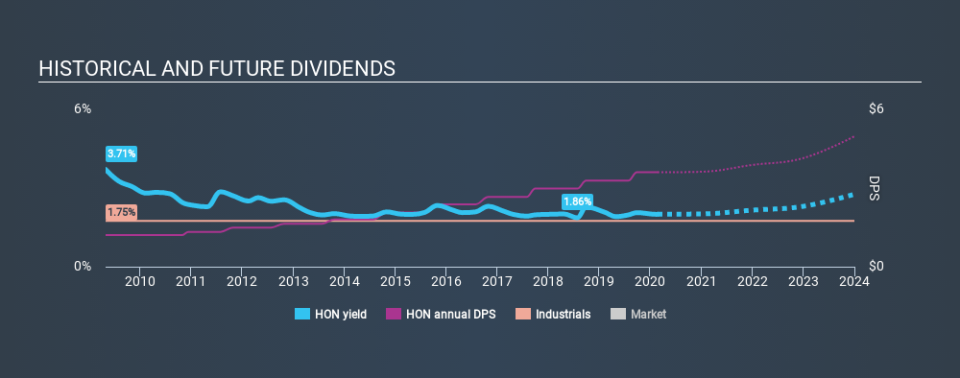Here's What We Like About Honeywell International Inc. (NYSE:HON)'s Upcoming Dividend

It looks like Honeywell International Inc. (NYSE:HON) is about to go ex-dividend in the next 4 days. This means that investors who purchase shares on or after the 27th of February will not receive the dividend, which will be paid on the 6th of March.
Honeywell International's next dividend payment will be US$0.90 per share. Last year, in total, the company distributed US$3.60 to shareholders. Calculating the last year's worth of payments shows that Honeywell International has a trailing yield of 2.0% on the current share price of $179.88. We love seeing companies pay a dividend, but it's also important to be sure that laying the golden eggs isn't going to kill our golden goose! That's why we should always check whether the dividend payments appear sustainable, and if the company is growing.
View our latest analysis for Honeywell International
Dividends are usually paid out of company profits, so if a company pays out more than it earned then its dividend is usually at greater risk of being cut. That's why it's good to see Honeywell International paying out a modest 39% of its earnings. Yet cash flows are even more important than profits for assessing a dividend, so we need to see if the company generated enough cash to pay its distribution. Thankfully its dividend payments took up just 40% of the free cash flow it generated, which is a comfortable payout ratio.
It's encouraging to see that the dividend is covered by both profit and cash flow. This generally suggests the dividend is sustainable, as long as earnings don't drop precipitously.
Click here to see the company's payout ratio, plus analyst estimates of its future dividends.
Have Earnings And Dividends Been Growing?
Stocks in companies that generate sustainable earnings growth often make the best dividend prospects, as it is easier to lift the dividend when earnings are rising. If business enters a downturn and the dividend is cut, the company could see its value fall precipitously. This is why it's a relief to see Honeywell International earnings per share are up 9.5% per annum over the last five years. The company is retaining more than half of its earnings within the business, and it has been growing earnings at a decent rate. We think this is generally an attractive combination, as dividends can grow through a combination of earnings growth and or a higher payout ratio over time.
Many investors will assess a company's dividend performance by evaluating how much the dividend payments have changed over time. Honeywell International has delivered 12% dividend growth per year on average over the past ten years. We're glad to see dividends rising alongside earnings over a number of years, which may be a sign the company intends to share the growth with shareholders.
Final Takeaway
Is Honeywell International an attractive dividend stock, or better left on the shelf? Earnings per share growth has been growing somewhat, and Honeywell International is paying out less than half its earnings and cash flow as dividends. This is interesting for a few reasons, as it suggests management may be reinvesting heavily in the business, but it also provides room to increase the dividend in time. It might be nice to see earnings growing faster, but Honeywell International is being conservative with its dividend payouts and could still perform reasonably over the long run. Overall we think this is an attractive combination and worthy of further research.
Curious what other investors think of Honeywell International? See what analysts are forecasting, with this visualisation of its historical and future estimated earnings and cash flow.
If you're in the market for dividend stocks, we recommend checking our list of top dividend stocks with a greater than 2% yield and an upcoming dividend.
If you spot an error that warrants correction, please contact the editor at editorial-team@simplywallst.com. This article by Simply Wall St is general in nature. It does not constitute a recommendation to buy or sell any stock, and does not take account of your objectives, or your financial situation. Simply Wall St has no position in the stocks mentioned.
We aim to bring you long-term focused research analysis driven by fundamental data. Note that our analysis may not factor in the latest price-sensitive company announcements or qualitative material. Thank you for reading.

